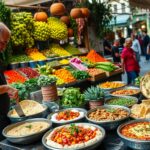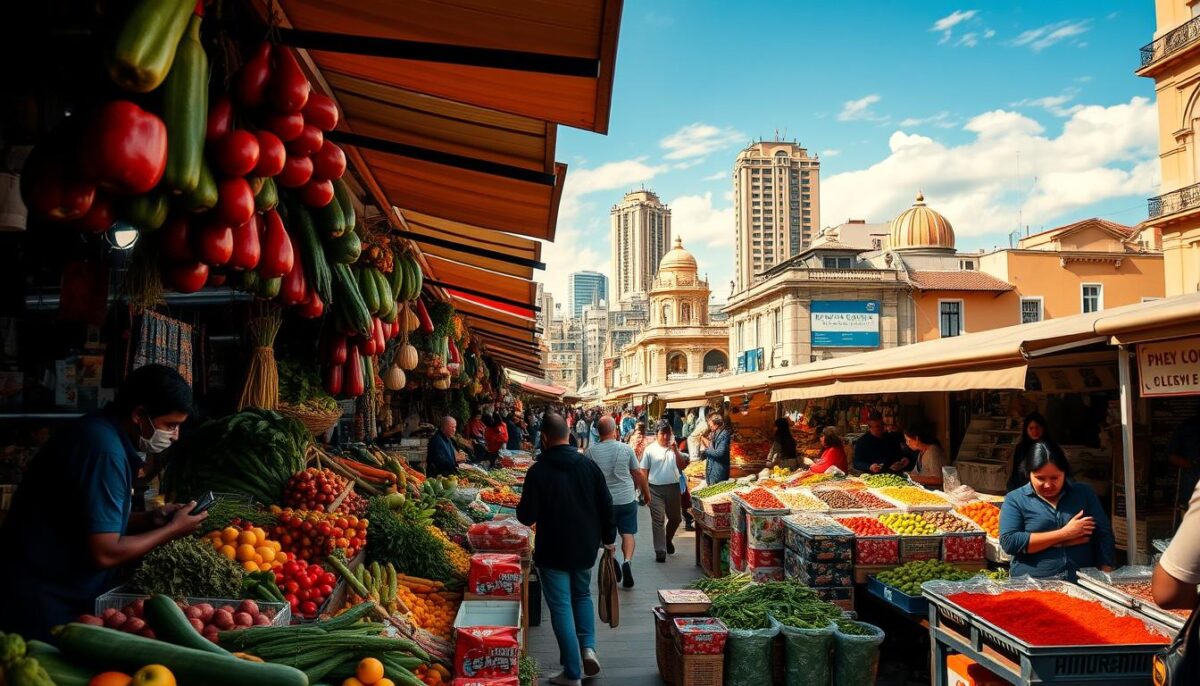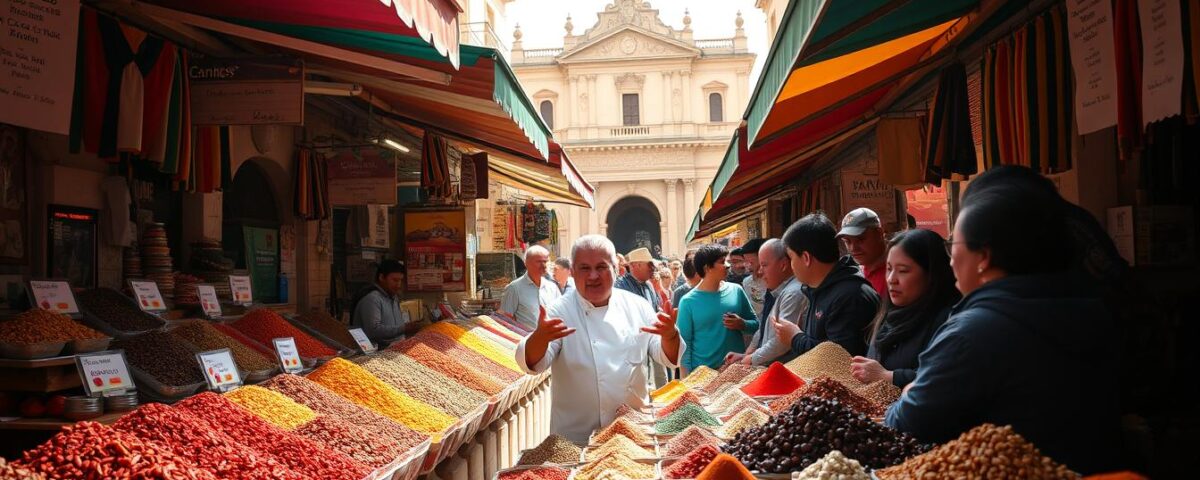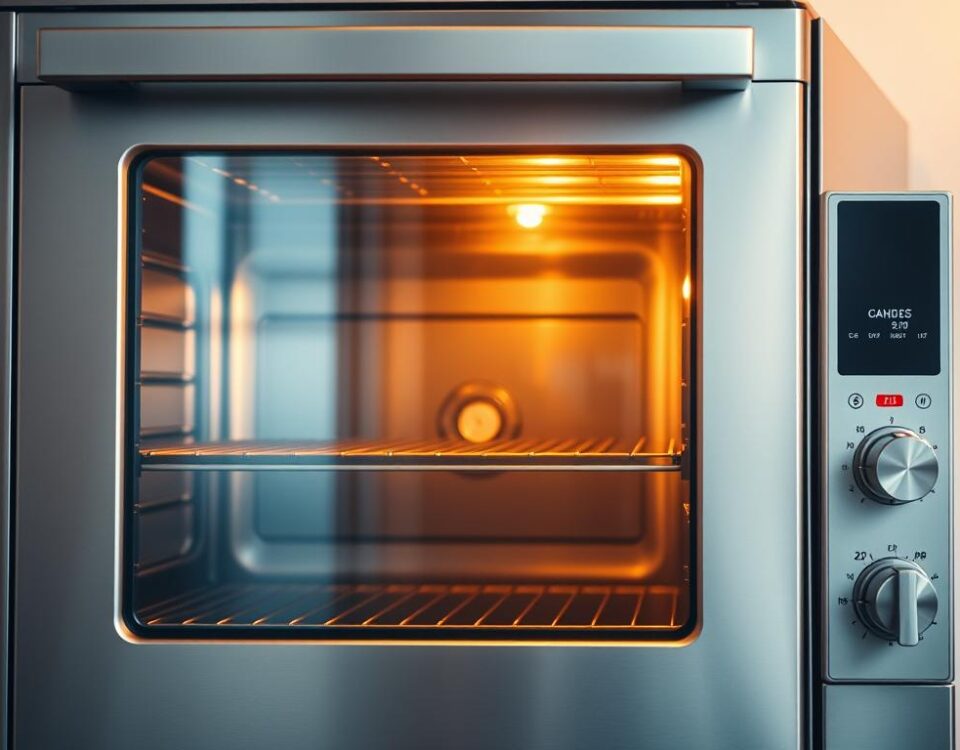
Top Things to Eat in Cape Town for a Flavorful South African Journey
June 13, 2025
What to Eat in Beirut If You Love Bold and Balanced Flavors
June 14, 2025Did you know Lima has 3 of Latin America’s top 10 restaurants—all within a 10-mile radius? That’s what fueled my mission: to savor this city’s legendary food scene in a single sunrise-to-sunset sprint. I woke before dawn, scribbling a map of markets, cevicherias, and hidden picanterías. My goal? To uncover how centuries of tradition collide with bold, modern creativity on every plate.
By 7 a.m., I was elbow-deep in a bustling market, where vendors handed me golden choclo corn and tart maracuyá fruit. “Try this,” a chef grinned, offering a rocoto pepper-stuffed olive that made my taste buds fireworks. Each stop revealed secrets—like how limes from Peru’s northern coast elevate ceviche, or why aji amarillo paste turns humble potatoes into magic.
What surprised me most? How seamlessly the day unfolded. From sipping pisco sours overlooking the Pacific to discovering a family-run anticucho grill at dusk, every flavor told a story. This wasn’t just eating—it was time-traveling through Incan roots, Spanish conquests, and Japanese-Peruvian fusion, all in 12 delicious hours.
Key Takeaways
- Lima’s markets offer hands-on access to fresh, exotic ingredients central to Peruvian cooking
- Traditional techniques like ceviche preparation often happen right in front of visitors
- Modern chefs artfully blend indigenous flavors with global influences
- Many tours prioritize hyper-local ingredients from specific regions of Peru
- Street food stalls provide authentic, budget-friendly tasting opportunities
- Daytime exploration allows for both breakfast traditions and late-night bites
Introduction: My Culinary Adventure in Lima
My journey into Peru’s iconic flavors began with a simple truth: great food tells stories. I’d studied causa rellena recipes for months, but nothing prepared me for the energy of a Lima morning market. Vendors shouted prices for purple corn while fishermen unloaded still-flapping corvina fish—this was where Peruvian cuisine came alive.
The food tour kicked off with a basket of lúcuma fruits and a challenge: identify five native ingredients blindfolded. Our guide laughed as I confused camu camu berries with passionfruit. “Now you understand why our dishes surprise visitors,” she said, handing me a spoonful of tumbo pulp that tasted like fizzy mango.
| Location | Experience | Key Elements |
|---|---|---|
| Local Markets | Hands-on ingredient selection | 40+ native produce varieties |
| Cooking Classes | Chef-guided preparations | Pre-Incan techniques |
| Street Stalls | Authentic flavor sampling | Family recipes since 1950s |
Working alongside chefs changed everything. María, a third-generation cook, showed me how to grind aji panca peppers on volcanic stone. “This mortar,” she tapped the weathered tool, “is older than your country.” We transformed simple ingredients into anticuchos that tasted like history with a side of lime.
What stayed with me? The way grandmothers chuckled at my knife skills while teaching potato peeling tricks. Lima doesn’t just share meals—it shares lifetimes of culinary wisdom. Every bite felt like joining a conversation that’s been simmering for 500 years.
Experiencing the Lima spice flavor tour
What transforms a meal into a cultural revelation? My answer came through an exploration blending sizzling skillets with centuries-old stories. Unlike typical food tours, this journey revealed how generations of cooks turn local harvests into edible art.

What Makes It Unique?
While other tours focus on tasting, this experience teaches through touch. At a family-run stall, I kneaded dough for tamales verdes while learning how Andean potatoes shaped Peru’s history. Guides emphasized connections—like why coastal limes pair perfectly with mountain-grown herbs.
Highlights from My Journey
Three moments stood out:
- Watching a chef balance aji amarillo heat with sweet chicha morada in seconds
- Tasting a grandmother’s street food recipe unchanged since the 1960s
- Discovering how Inca freezing techniques influence modern Peruvian dishes
The real magic? How every bite bridged past and present. At a market stall, a vendor demonstrated ancient corn-toasting methods while discussing TikTok food trends. This culture doesn’t just preserve traditions—it reinvents them daily.
Exploring Authentic Peruvian Dishes
Peruvian cuisine reveals its soul through plates that dance between history and innovation. My taste buds became time travelers—one moment savoring ancient Andean methods, the next encountering Japanese-Peruvian fusion. The magic lies in how chefs honor roots while rewriting rules.
Savoring Ceviche, Lomo Saltado, and More
I’ll never forget the ceviche that made me gasp. A chef sliced fresh corvina fish tableside, then bathed it in leche de tigre—a citrus marinade that “cooks” the seafood instantly. “This lime juice?” he winked. “From trees older than your grandparents.”
At a cozy bistro, lomo saltado arrived sizzling—tender beef stir-fried with vinegar-soaked onions. The secret? A splash of pisco liquor flambéed into the wok. Each bite fused Chinese wok techniques with Peruvian mountain spices.
Traditional Techniques and Local Ingredients
Watching cooks grind aji amarillo peppers on stone mortars explained why shortcuts fail. One grandmother showed me how to layer causa limeña—mashed yellow potatoes with avocado and chicken—using palm strokes perfected over decades.
| Dish | Traditional Method | Modern Twist |
|---|---|---|
| Ceviche | Marinated in clay pots | Infused with ginger foam |
| Lomo Saltado | Wood-fired cooking | Quinoa crusted beef |
| Causa Limeña | Hand-pressed potatoes | Sea urchin garnish |
What makes these dishes unforgettable? Local ingredients like cancha corn from Sacred Valley farms. At the market, I tasted purple potatoes that chefs roast instead of fry—preserving flavors unchanged since Inca times.
Every meal felt like decoding Peru’s culinary traditions. Whether learning preparation tricks from street vendors or admiring avant-garde plating, the balance between heritage and creativity left me hungry for more.
Navigating Lima’s Bustling Markets and Street Food
The scent of roasting anticuchos hit me before I saw the smoke—charred meat and aji panca paste swirling through the morning air. This wasn’t just shopping; it was a treasure hunt where every stall held edible gold.

A Walk Through the Colorful Markets
At Surquillo Market, baskets overflowed with alien-looking fruits—spiky granadillas and fuzzy tuna cactus fruits. A vendor pressed a sample of chirimoya into my palm. “Tastes like angels sing,” she grinned. She wasn’t wrong.
Guided tours here feel like backstage passes. Our group followed a chef who revealed why certain potatoes only grow at specific altitudes. We tasted street food legends: papas rellenas stuffed with olives from Ica, and churros dusted with Amazonian cinnamon.
The city’s energy peaks in these spaces. Fishermen argued over yesterday’s catch while grandmothers bartered for quinoa. One moment I’m sipping emoliente tea from a street cart, the next learning to spot ripe lúcuma by its sunset-orange flesh.
This trip taught me markets are Peru’s living cookbooks. Every ingredient whispers stories—Incan terraces, Spanish trade routes, Japanese immigration waves. By noon, my bag bulged with cancha corn and handmade chocolates, proof that the best journeys leave crumbs.
Hands-on Cooking with Local Chefs
I never thought I’d cry over mashed potatoes until Chef Rosa handed me a volcanic stone mortar. “This is how my bisabuela made causa rellena,” she said, demonstrating the rhythmic grinding of yellow potatoes. My morning in a Peruvian kitchen workshop became a masterclass in edible history.
Learning Traditional Methods
Working alongside third-generation chefs, I discovered why shortcuts fail here. We used banana leaves as steaming vessels and balanced flavors with native herbs like huacatay. “Taste with your fingers first,” instructed Chef Marco as I shaped dough for tamales. His family’s techniques—like toasting corn in clay pots—dated back to pre-Columbian times.
| Technique | Traditional Tool | Modern Adaptation |
|---|---|---|
| Potato Preparation | Volcanic stone mortar | Food processor (rarely used) |
| Mortar Grinding | Batán stone | Blender for sauces only |
| Marinating Fish | Chilled clay bowls | Stainless steel containers |
Creating My Own Culinary Masterpiece
My hands trembled assembling the dish that would define my crash course. Layers of seasoned potato, avocado, and shredded chicken needed perfect compression. “More ají amarillo!” Chef Rosa urged. The final touch? A quail egg from her backyard coop.
Tasting my lopsided culinary creation brought unexpected pride. The spicy-sweet balance mirrored market flavors I’d sampled earlier. Our group’s tasting session revealed how ingredient ratios transform comfort food into art.
This wasn’t just cooking—it was decoding generations of wisdom. As I boxed my dish to share with vendors, I realized these chefs don’t just teach recipes. They pass down stories you can taste.
Immersing in Lima’s Culinary Culture and Heritage
Every bite here feels like a handshake between continents. Lima’s kitchens simmer with stories—Incan terraces meet Spanish olive barrels, Japanese umami dances with Andean potatoes. This city doesn’t just serve meals; it stages edible theater where heritage whispers through every recipe.
Fusion of Global Influences and Local Flavors
At a corner pollería, I tasted chicken marinated in Chinese soy sauce and native aji mirasol. “My grandfather learned this from a Cantonese miner,” the owner explained. Dishes here rewrite borders—Italian pastas gain altitude with huancaina cheese sauce, while Amazonian fruits elevate French pastries.
What defines this culture? Resilience. Chefs honor ancestral crops like oca tubers while embracing global techniques. One chef showed me how to smoke quinoa using Japanese binchotan charcoal. “Our country’s history lives in these flavors,” he said, grating fresh wasabi root over ceviche.
My journey through kitchens revealed how food lovers protect traditions. Grandmothers still grind corn in stone mortars, while young innovators ferment chicha in craft breweries. Every meal became a passport—to Incan feasts, colonial bakeries, and Nikkei sushi bars.
This experience changed how I see the world. Lima taught me that great cuisine isn’t about purity—it’s the art of weaving heritage into something boldly new. Here, every plate proves that the best recipes are written by time.
Conclusion
My taste buds still hum with memories of Peruvian cuisine—a whirlwind journey through markets buzzing with alien fruits and kitchens where chefs became historians. From sunrise ceviche sessions to shaping tamales alongside third-generation cooks, every moment deepened my appreciation for how ingredients become edible time capsules.
Key takeaways? The street food vendor’s decades-old anticucho recipe that outshone fine dining. The way local chefs balanced ancestral techniques with modern flair. Even my clumsy attempts at culinary traditions revealed why shortcuts fail here—Peru’s flavors demand patience and passion.
For food lovers craving more than a meal, Lima offers transformative experiences. Choose between dawn market crawls or evening pisco pairings at chic restaurants. Either way, you’ll taste how geography and history simmer in every dish.
This trip taught me that great cuisine isn’t just eaten—it’s felt. Whether you’re squeezing limes at a cooking class or debating chili varieties with vendors, Lima’s kitchens invite you to join a conversation centuries in the making. Ready to write your own food story?
FAQ
What dishes should I prioritize trying during a food-focused day in Lima?
Don’t miss classics like ceviche (fresh fish cured in citrus), lomo saltado (stir-fried beef), and causa (layered potato dish). Each bite reflects the country’s history and blend of indigenous, Spanish, and Asian influences.
How do local chefs incorporate traditional techniques into modern dishes?
Many use ancestral methods like marinating in ají peppers or slow-cooking in clay pots, paired with fresh, seasonal ingredients from nearby farms and coastal waters. It’s a delicious balance of old and new.
Are street food options safe for travelers to try?
Absolutely! Stalls in markets like Surquillo or Barranco are trusted spots. I always look for busy vendors—it means high turnover and fresh ingredients. Try anticuchos (grilled skewers) or picarones (sweet potato doughnuts).
What’s the best way to understand Peru’s culinary heritage in a short time?
Join a guided tasting tour. You’ll explore markets, meet vendors, and sample iconic dishes while learning about the fusion of Andean, European, and Asian flavors that define the cuisine.
Can I participate in cooking classes without prior experience?
Yes! Classes are designed for all skill levels. I learned to make ceviche from scratch using local lime and rocoto peppers—chefs guide you step-by-step, making it fun and accessible.
When’s the ideal time to visit markets for the freshest ingredients?
Early mornings are best. Markets buzz with activity as chefs and families shop for the day. You’ll see vibrant produce, freshly caught seafood, and hear stories behind staple ingredients like quinoa and purple corn.



